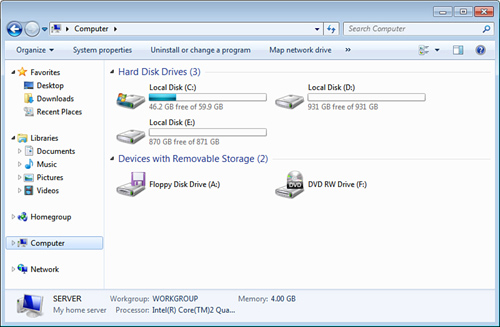Although Windows Home Server
2011 comes with many new and useful features—the Dashboard, the
Launchpad, improved Mac support, easier remote access, and more—all
anyone seems to talk about is what’s not in Windows Home Server 2011. I speak, of course, of Drive Extender, the file system technology that in version 1 of Windows Home Server made disk management supremely simple by offering data
redundancy in the form of folder duplication, a seamlessly expandable
pool of storage data that could span multiple hard drives, and load
balancing.
As I write this just before
the launch of Windows Home Server 2011, it’s unclear why Microsoft
removed Drive Extender so abruptly, and we may never know the full
story. What is clear is that Microsoft is relying on system vendors and
other third parties to come up with innovative storage solutions that
mimic or surpass what Drive Extender could do, and no doubt there are
lots of clever people working on just that.
However, it’s also clear that many of the tools you
need to mimic most of the functionality of Drive Extender are already
present in Windows Home Server 2011. Or, to be more accurate, those
tools are present in the OS that underlies Windows Home Server 2011:
Windows Server 2008 R2. Here’s a summary:
Data redundancy— You can mimic this Drive Extender feature by using the Disk Management snap-in feature called mirroring.
Expandable storage pool— You can mimic this Drive Extender feature by using another Disk Management feature called a spanned volume.
Redundancy, expandability, and load balancing— You can reproduce almost everything in Drive Extender by using Disk Management to implement a RAID 5 volume.
For now, however, let’s take a quick look at how
Windows Home Server 2011 handles storage without these tricks (and, of
course, without Drive Extender).
Server Storage on a One-Drive System
If you have just one hard drive on your system,
Windows Home Server divides the hard drive into two unnamed partitions,
as shown in Figure 1:
one for the Windows Home Server system files, which is seen as drive C:
in the Computer folder, and another for the data, which is seen as
drive D: in the Computer folder. Note, too, that in Windows Home Server
2011 the size of drive C: is 60GB, which is a welcome increase from the
mere 20GB assigned to the system drive in previous versions of Windows Home Server.

How do you know the data gets stored on drive D:?
Open the Windows Home Server Dashboard, click the Server Folders and
Hard Drives icon, and then click the Server Folders tab. As you can see
in Figure 2, the Location column shows that each Windows Home Server folder resides in D:\ServerFolders.

Server Storage on a System with Two or More Drives
Windows
Home Server lets you add as many drives as you can either fit inside
the case or plug into your system’s USB (2.0 or 3.0), FireWire, and
eSATA ports. If you install Windows Home Server 2011 on a single-drive
system and then add a second drive, what happens next depends on the
status of the drive. If the drive is uninitialized (that is, not
partitioned and not formatted), Windows Home Server 2011 generates
information alert for the server, which you can see in Figure 3.

Clicking the Format the Hard Disk link at the bottom
of the alert message initializes the drive and makes it available in the
Dashboard’s Server Folders and Hard Drives section (in the Hard Drives
tab). From there you can either configure the drive for server backups, or you can move any of the default Windows Home
Server data folders to the new drive.
However, instead of adding a new drive to an existing
Windows Home Server installation, you might instead install Windows
Home Server on a system that already has two drives attached. In this
scenario, Windows Home Server does a slightly odd thing. As with a
single-drive install, Windows Home Server divides one hard drive into
two unnamed partitions:
one for the Windows Home Server system files, which is seen as drive C:
in the Computer folder, and another for the data, which this time is
seen as drive E: in the Computer folder (see Figure 4). The extra drive is formatted with a single partition and assigned drive D:.

Again, we can confirm that the data gets stored on
drive E: by opening the Windows Home Server Dashboard, clicking the
Server Folders and Hard Drives icon, and then clicking the Server
Folders tab. As you can see in Figure 5, the Location column shows that each Windows Home Server folder resides in E:\ServerFolders.